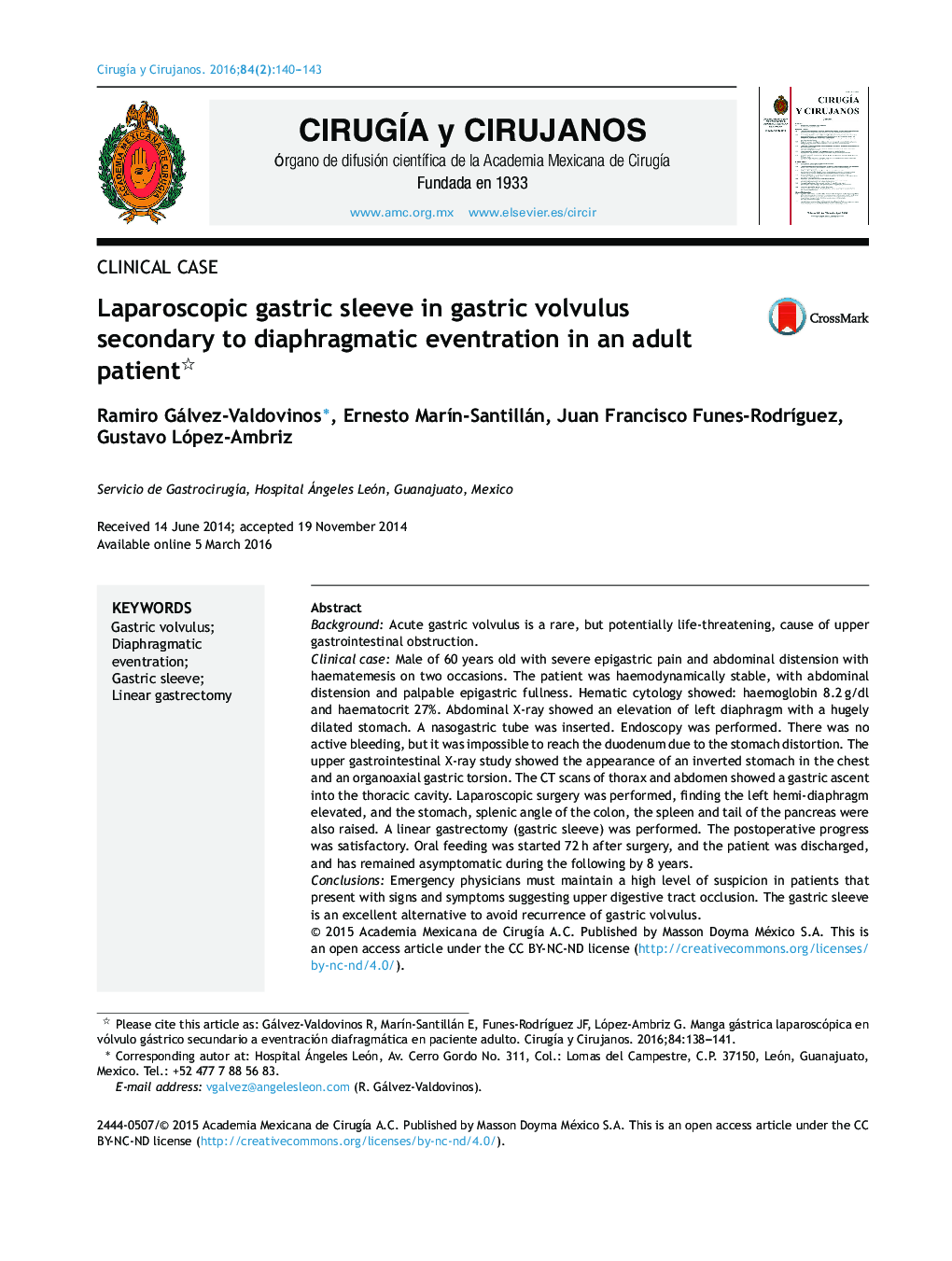| کد مقاله | کد نشریه | سال انتشار | مقاله انگلیسی | نسخه تمام متن |
|---|---|---|---|---|
| 4283334 | 1286881 | 2016 | 4 صفحه PDF | دانلود رایگان |

BackgroundAcute gastric volvulus is a rare, but potentially life-threatening, cause of upper gastrointestinal obstruction.Clinical caseMale of 60 years old with severe epigastric pain and abdominal distension with haematemesis on two occasions. The patient was haemodynamically stable, with abdominal distension and palpable epigastric fullness. Hematic cytology showed: haemoglobin 8.2 g/dl and haematocrit 27%. Abdominal X-ray showed an elevation of left diaphragm with a hugely dilated stomach. A nasogastric tube was inserted. Endoscopy was performed. There was no active bleeding, but it was impossible to reach the duodenum due to the stomach distortion. The upper gastrointestinal X-ray study showed the appearance of an inverted stomach in the chest and an organoaxial gastric torsion. The CT scans of thorax and abdomen showed a gastric ascent into the thoracic cavity. Laparoscopic surgery was performed, finding the left hemi-diaphragm elevated, and the stomach, splenic angle of the colon, the spleen and tail of the pancreas were also raised. A linear gastrectomy (gastric sleeve) was performed. The postoperative progress was satisfactory. Oral feeding was started 72 h after surgery, and the patient was discharged, and has remained asymptomatic during the following by 8 years.ConclusionsEmergency physicians must maintain a high level of suspicion in patients that present with signs and symptoms suggesting upper digestive tract occlusion. The gastric sleeve is an excellent alternative to avoid recurrence of gastric volvulus.
ResumenAntecedentesEl vólvulo gástrico agudo es un problema infrecuente como causa de obstrucción gastrointestinal.Caso clínicoPaciente varón de 60 años que acude a urgencias por dolor epigástrico severo acompañado de distensión abdominal, con hematemesis en 2 ocasiones. A la exploración física: hemodinámicamente estable, con distensión abdominal en epigastrio, ruidos abdominales disminuidos; la citometría hemática mostró: hemoglobina 8.2 g/dl y hematocrito de 27%. La radiografía de abdomen mostró: elevación del hemidiafragma izquierdo y gran dilatación de estómago; por lo que se le colocó sonda nasogástrica. Por endoscopia no se observó sangrado activo, siendo imposible alcanzar el duodeno por torsión gástrica. El estudio con medio de contraste mostró: estómago invertido dentro del tórax y con torsión gástrica axial. La tomografía de tórax y abdomen confirmó los hallazgos, con diagnóstico de vólvulo gástrico por eventración. Se procedió a efectuar laparoscopia, encontrando: hemidiafragma izquierdo elevado, así como estómago, ángulo esplénico del colon, bazo y cola del páncreas. Se realizó gastrectomía lineal (manga gástrica). La evolución fue satisfactoria; se inició alimentación por vía oral 72 h después de la cirugía, y el paciente fue dado de alta, con seguimiento de 8 años, en los que permanece asintomático.ConclusionesEl médico de Urgencias debe mantener un alto índice de sospecha en pacientes que presentan signos y síntomas sugestivos de oclusión intestinal alta. El manejo con gastrectomía lineal (manga gástrica) es una excelente alternativa para evitar la recidiva.
Journal: Cirugía y Cirujanos (English Edition) - Volume 84, Issue 2, March–April 2016, Pages 140–143